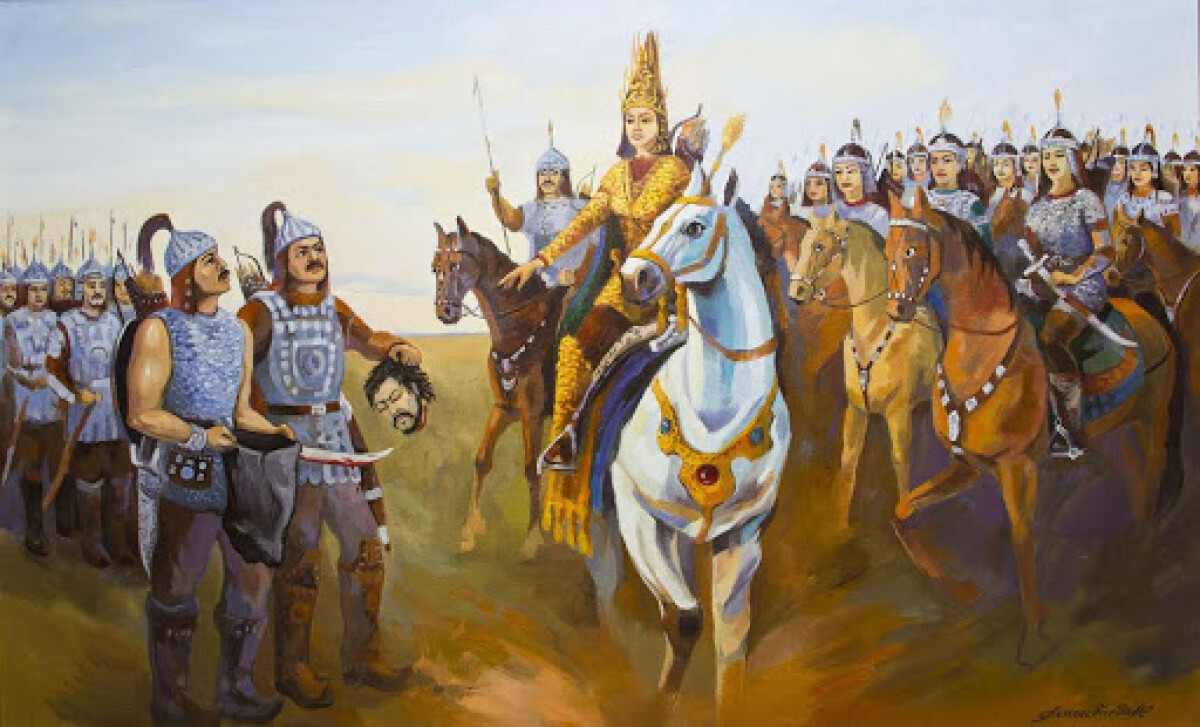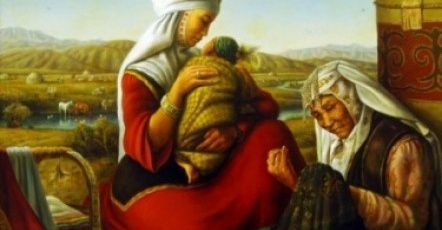
The love and heroic deeds of such princesses as Tumar, Zarina, Begim, Bopay, Karashash, Domalak, Abak, Aiganym, Kunbike, Zere, preserved in the memory of the people, will be remembered by the future generations. Aiganym, Mrs. Bopay, Kunbike, Aibike, Zere, who ruled the country since the days of the Kazakh Khanate, have a special place in the history of the nation.
The Internet project “History of Kazakhstan” presents the project “Great personalities of the Great Steppe”. The project is about our great people, whose names are written in golden letters in the history of the country. In this issue, we want to provide information about our heroic mothers in Kazakh history.
The love and heroic deeds of such princesses as Tumar, Zarina, Begim, Bopay, Karashash, Domalak, Abak, Aiganym, Kunbike, Zere, preserved in the memory of the people, are remembered by the future generations. Aiganym, who ruled the country since the days of the Kazakh Khanate, Mrs. Bopay, Kunbike, Aibike, Zere, who ruled the country, have a special place in the history of the nation.
In the history of the Kazakh Khanate, there are not many Kazakh girls among the historical figures included in the archival documents at the state level. When we talk about them, we mention the names of Mrs. Bopay, the wife of Abulkhair Khan, Mrs. Aiganym, the wife of Uali Khan, the glorious sister of Kenesary Khan Bopay. Kazakh women were acquainted not only with prominent Kazakh personalities of the time, but also with the statesmen from Russia, Khiva, Bukhara and other countries. This shows the activity of Kazakh girls in the public and political life. Of course, during the difficult period of the Kazakh Khanate, Mrs. Bopay helped the Kazakh Chief Khan Abulkhair and supported her husband in difficult times. After the khan's death on August 15, 1748, she was a mentor not only to her family but to all Kazakhs. Mrs. Bopay, who has been a role model for a long time, has a special place.
Mrs. Bopay
Mrs. Bopay — (about 1690 – 1780 years) was the wife of Abulkhair khan, a very beautiful, smart, courageous figure, who was involved in governing the country.
Bopay is the daughter of Syuindik, the eldest son of the hero Tabynai from the Adai clan of the younger zhuz. Ms. Bopay's name appears in historical documents after 1731 in the Russian archives. During this period, he became not only the leaven of the family of Abulkhair khan, but also, the supporter of all political steps of the khan. Bopay was called the mother of the country, and none of her sons were vulnerable, she brought them up to be remembered in history. Information about Bopay's sympathy for the art and science is preserved in historical data. He helped the museum, that was organized by the Russian tsar first, in order to collect information about the ethnography of the Kazakh people.
Bopay was the politician, statesman and activist in 1748. It appears in a letter dated October 5 to Elizoveta Petrovna, as of November 22, 1731, to the Queen Anna Ioanovna. This is a real historical document that reveals the reality of that time. On November 12, 1742, ensign Muravin, who was with Abulkhair, told about the gifts that Queen Bopay received from the royal palace. There was written in the magazine: “1 goal, 1 pair of sobols, 1 strawberry, 2 handkerchiefs of Italian beads, 2 protrusions, 2 beavers, Chernobyl fur price – 100 rubles, 50 rubles money, Abulkhair khan after taking a silver rule with turquoise price 65 rubles copper rim, iron shell with the announcement that he is a khan, that weapon serves against enemies e.i.v. and the protection of his health”. Bopay's beauty and intelligence were special. The English artist John Castle visited the royal palace in 1736, when Bopay was in his mid-40s and painted with great interest. Bopay was talented and literate. He corresponded with senior Russian government officials (about 40) and kept a personal seal. On July 8, 1751, Bopay arrived in Orenburg and stayed there until August 7, when he was received by the Governor.
Bopay's cemetery is located 70 km south part of Sol-Iletsk region, on the border with Shyngyrlau district of Uralsk region. There is a year called “Bopay gorge”, locating next to it.
Mother Karkabat
He is descended from one of the most grown-up ancestors in Argyn - Meiramsopy. Most of the genealogical data say that Meiramsopy's godmother Nurpiya was born from Kuandyk, Syuindik, his second wife is Begendik, Shegendik, and his third wife — Bolatkozha (Karakesek). The descendants of each of them became one fundamental tribe.
Meiramsopy was so respected and served by Karkabat that all his life he waited for Meiram without touching his feet or touching his flesh with cold water. When the firewood comes out of the desert, the squirrel pulls out a sack, puts it under the feet of the head of the family, and warms the pitcher on his brother, who performs the ablution at night. Every time he saw Karkabat's desire, Meiramsopy said, “Oh, let your eyes be blue! May you have more than one brother! Follow the motto of your generation!” seems to be a blessing. The blessing of the ghostly grandfather was accepted, Karakeseks became a fundamental country, there were 25-26 districts, the country and the land became famous, the name of Karkabat mother became the motto of the Karakesek clan (The data was given by Galymzhan Mukatuly (1905-1976)).
Akbikesh Aru
One of the spy heroes of Esim Khan. She lived in the XVII century. She was a brave girl who took part in the expeditions of the troops to Bukhara, Kashgar and Kalmykia. She helped the Kazakh troops a lot, mainly by accurately predicting the location of distant enemy troops. According to the legend, she had a special ability to see and predict. When Akbikesh returned to his homeland, she built a high tower in Karatau region and looked around from it. According to the same legend, Akbikesh was captured by the Dzungars and her eyes were gouged out.
Bopay is beautiful
Bopay is beautiful. Bopay (the years of birth and death unknown) is one of the active participants in the uprising of Kenesary Kasymuly, Kenesary's sister. She was born in Kokshetau. Kassym is the only daughter of 6 sons of the nobleman Sanzhar, Esenkeldy, Agatai, Koshek, Kenesary, Nauryzbai. It is also found in the data as Bopy. When Bopay was a girl, she was given to Abulkhair's son Sameke. From an early age, she was known for her beauty and courage. She persuaded her husband and her relatives, Sultan Sarteke and Dosan Abulkhair, in order to join the uprising process. Being unable to obtain their consent, in 1837, she joined the rebels with her six children. Bopay led a 600-strong contingent in order to provide the insurgents with food, weapons and clothing. She took up her arms at critical times, fought in the wars, and was taken as the prisoner. In all of this, she was known for her courage, perseverance and intelligence.

In the final battle of Kenesary Khan in Kyrgyzstan, she took part in the attack along with his brother Bopay.
A historian Serik Azhigali states in his monograph that Bopay was buried 15 km on the north-west part of Kilemzhaigan village, Aiteke bi district, Aktobe region.
There is a village named after Bopay in Aiteke bi district of Aktobe region, near the Irgiz district.
Mrs. Aiganym
Mrs. Aiganym (1783 -1853) lived in the Syrymbet jailow of the present-day, North Kazakhstan region. She the youngest wife of Uali khan. She influenced the socio-political life of North Kazakhstan. She was a leading woman of her time, she knew several languages of the East. She corresponded with the Russian Foreign Ministry's Asian Department in St. Petersburg and maintained close contacts with officials in Omsk, Tobol, and Petropavl.
Aiganym is the youngest wife of Uali, the first son of Ablai Khan. In other words, she is the daughter-in-law of Ablai, whose fame spread all over the world, who united the six Alashes, and who was not equally created to his intellect. She the mother of Genghis Khan, grandmother of the famous scientist Chokan. She was praised and respected widely. Her last name Kudaiberli Baimbet, tribe Atygai. The other side of her father Sargaldak is the famous to Malim Khozha. In fact, Aiganym does not belong to the noble family. However, the fact that she “Came out of the darkness and became a khan” means that the fate of the queen, which was given to her by the Lord, was exalted as well. Thus, she rose to the rank of the greatest public figure among the Kazakh women of that time and took the reins of the country. She is a grown mother of nine children. From the time of Genghis Khan, she helped her children to receive education in the Russian language.
As we refer to the information about Ms. Aiganym, who was born in 1783, she did her best and showed the spirit of a Kazakh girl. Her mother was an Uzbek girl. Her father Sargaldak is an open-minded person, and he helped Aiganym to get an education. She is fluent in Arabic, Persian, Chagatai and Russian. She also learned French, that was the fashion of the Russian aristocracy at that time. She also knows the history and philosophy of the East. With that knowledge, she became not only Wali's wife, but also his advisor and chief advisor on the internal and external issues.
In her time, Tsar Alexander I ordered to build a complex for wintering in the depths of Syrymbet. Five thousand rubles were allocated for the construction of these facilities, and the government set a pension of 400 rubles. Ms. Aiganym's decision to build this settlement was to get an education in agriculture and entrepreneurship, and to move from the nomadic to the sedentary. She invited the Russian masters and built a ten-room pine house, a mosque, madrasah and the palace in the yard. In the built madrasah, she gathered the children from all walks of life in the region, rich and poor, and she was teaching the Russian, world studies, and art, as well as religious subjects. The famous mullah Kulmuhammed was hired to teach. Near the settlement, there is an eternal home of Mrs. Aiganym and Uali. There is a tombstone on their heads. Ms. Aiganym, who celebrated in a historic settlement, left her mark in Kazakh history as a political and public figure who was able to gain power on her own, received a European education, and spoke several languages as well.
Gaukhar Batyr
Gaukhar Batyr was born in Urzhar, East Kazakhstan region, the wife of the famous Karakerei Kabanbay Batyr, the sister of Basentiin Malaysary Batyr, a hero and dancer of the Middle Zhuz, who lived about 1700-1756 years ago. She is one of the most remembered women for her heroism during the Kazakh-Kalmyk war. Nazym, the eldest son of Kabanbay and Gaukhar, is also famous for his heroic deeds.
In 1724, the Dzungar army captured the city of Turkestan and began a continuous attack. When Kabanbay was about to attack the Dzungars, Gaukhar bravely broke through the siege of the Dzungars and gave to Kabanbay the detailed information about the enemy's situation. A victory of the famous “Bulanty” in 1725 was the result. Later, Gaukhar became Kabanbay's life partner and after a while, she became “Gaukhar Batyr”. The name of Gaukhar Batyr, who called the call to prayer, was probably Maysara.
Sapura (Koktemir) batyr
Sapura Matenkyzy lived about 1753–1776 years ago. A researcher Anes Saray, in an article published in the journal “Women of Kazakhstan” in February 1997, claims that Sapura was born in 1753 near Kobda region, now it is the region in Aktobe. She was born in the family of Maten Batyr, who lived along the Kobda River in Aktobe region. At the age of sixteen or seventeen, Sapura married a middle-class man in that country.
Sapura, a 22-year-old young woman, was killed by her fugitive Kalmyks and joined her brother-in-law Zhanbolat. She moved to the village of Dosaly Sultan with two thousand people along the Kobda. She is a legendary commander of the struggle against the Russian army, which came to suppress the peasant struggle in the Russian Empire. As if embarrassed to start with a woman's head, she spreads a legend about a mysterious person walking in the steppe – “Koktemir”. An invisible fighter takes the lead in the fight. However, the Russian army did not know only that she was a woman, but also who she was, and only the name “Koktemir”. There are rumors about the “Invisible Koktemir Batyr”.
A well-known historian, Islamgali Bitik's article “Do we know about Sapura Matenkyzy” says that the period of Sapura's life was the period of the Pugachev uprising.
“Historically, this was a time when the Kazakh people, especially in the Lesser Zhuz, suffered the brutal punishment of the post – Emelyan Pugachev uprising”, thinks of shelter.
In the autumn of 1775, the people of the Tama tribe, sitting at the mouth of the Elek and Kobda rivers, went to strike on the horseback. This movement is historically known as the “Koktemir Uprising”. It should be noted that Sapura Matenkyzy was both the instigator and motor of the strike. Her husband, an energetic young man Zhanbalta, was next to her.
Sapura's unique movements on the horseback, wrestling tactics and orientation increase the country's confidence in her.
The Kazakh people, longing for the independence, have high hopes for the actions of Emelyan Pugachev. After all, he assured that the best days will come. The country will be given an independent state, equality and freedom. Putting it this way, the Ural-Orenburg Cossack-Russians will be under the jurisdiction of the Kazakh Khanate. However, Nuraly, the khan of the Younger Zhuz, did not believe so.
Nevertheless, there were many people who supported Pugachev's idea and fought openly and secretly. However, the death of the leader of the uprising seemed to put an end to the unhappiness.
Only the brave woman Sapura Matenkyzy could not stop. “She chanted Pugachev's name and decided to unite his former companions, the Cossack-Russians along the Urals, the Kalmyks on the other side and the Bashkirs on another side, and even the Mordovians, Chuvashs and Cheremis”, said I. Bitik.
According to the Russian sources, Sapura Matenkyzy, known in the Kazakh steppes during the Pugachev uprising as an “Invisible pole” and “Invisible soul”, also died in mysterious circumstances. However, due to those who sacrificed their lives for the dawn of freedom, the dream of freedom has come closer to us.
References:
1. “Great names of the Great Steppe. Collection of articles” book
2. “Great names of the Great Steppe. Collection of articles” book. Great people in the history of Kazakhstan. As an aid to the curators of student groups. Book 3 / edited by Academician of the National Academy of Sciences of the Republic of Kazakhstan A.M. Gazaliev. – 2nd edition, edit. And complete. – Karaganda: Karaganda State Technical University Publishing House, 2011. – 120 p.
3. “Egemen Kazakhstan” newspaper article by N. Nazarbayev “Seven edges of the Great Steppe”
4. English Wikipedia database.

